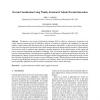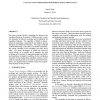85 search results - page 16 / 17 » Adaptive Robot Coordination Using Interference Metrics |
AROBOTS
2005
13 years 8 months ago
2005
We present a new terrain classification technique both for effective, autonomous locomotion over rough, unknown terrains and for the qualitative analysis of terrains for exploratio...
IJSNET
2010
13 years 2 months ago
2010
: Cooperative communications have been demonstrated to be effective in combating the multiple fading effects in wireless networks, and improving the network performance in terms of...
WSC
2008
13 years 10 months ago
2008
This paper presents PiDES, a formalism for discrete event simulation based on Pi-calculus. PiDES provides a rigorous semantics of behavior modeling and coordination for simulation...
ICRA
2006
IEEE
14 years 2 months ago
2006
IEEE
— We present a system of coupled nonlinear oscillators to be used as programmable central pattern generators, and apply it to control the locomotion of a humanoid robot. Central ...
TROB
2002
13 years 7 months ago
2002
The objective of the CyberScout project is to develop an autonomous surveillance and reconnaissance system using a network of all-terrain vehicles. In this paper, we focus on two f...



